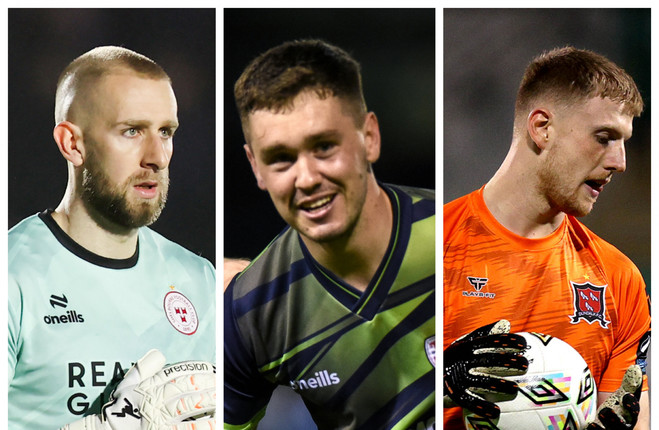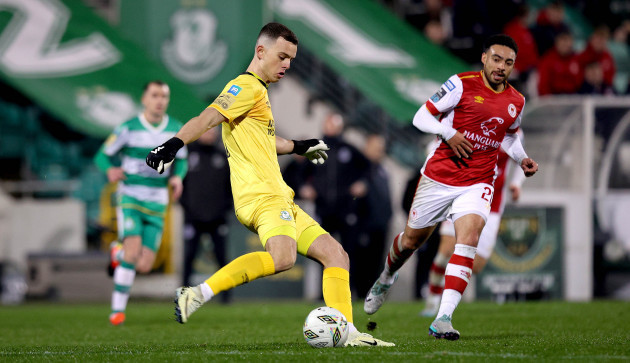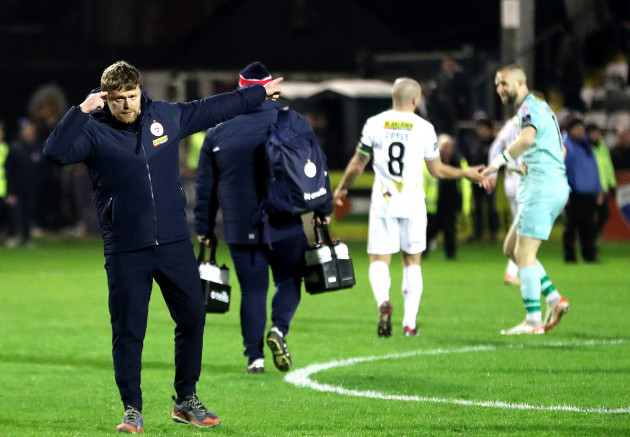CONSISTENCY IS THE name of the game for any goalkeeper.
There may be more demands being placed on the number ones in the modern game, an expectation to be as comfortable in possession in your own six-yard box as you are with commanding it in the air, but so far in the League of Ireland Premier Division we have seen that supposed old-school values remain to the core when assessing performance.
Last week, St Patrick’s Athletic manager Jon Daly was asked about his decision to drop on-loan Liverpool goalkeeper Marcelo Pitaluga in favour of the more experienced Danny Rogers for the Saints’ 1-0 win over Dundalk.
“Danny looked assured,” Daly explained. “It’s like any position, if someone is not performing, the change is made.
“To be fair to Marcelo, he found it difficult at the start. It doesn’t mean he’s not a good goalkeeper. He’s had a couple of situations, the President’s Cup and last week in Waterford. He’s had a couple I felt he should have done better with.”
The Brazilian did also look uncomfortable when trying to use the ball and distribute it, but what cost him his place was an inability to keep the ball out of his net by being better at the bare minimum.
Pitaluga’s situation is not too dissimilar than George Shelvey’s at Dundalk.
The 22-year-old arrived on a permanent deal from Premier League side Nottingham Forest and after a relatively impressive start away to champions Shamrock Rovers – who have promoted former No.2 Leon Pohls after losing Alan Mannus – he suffered the blow of being substituted at half-time when he conceded four first-half goals against Sligo Rovers earlier this month.
Building and maintaining trust among your teammates is as important in terms of the basics of the game as it is proving your ability with the ball at your feet.
The days of goalkeepers spending 45 minutes of training alone in the corner of the pitch before getting involved in a match to make up numbers at the end are gone.
They are now part of the match-specific passing drills built into the session with an emphasis on ensuring they are not only comfortable using the ball, but understand how best to do so in certain situations.
Managers are not just looking for numerical superiority in midfield, it’s the same in their own box where goalkeepers are being asked to step in as a third centre half. It’s not just a case of defenders knowing they can fire a pass back to get out of trouble, the keeper is the catalyst.
Creating angles for a pass with the correct body shape and appreciating what type of delivery is required is as vital as the match-specific work done in training, the sort that informs a goalkeeper about whether they will need to be front-footed and proactive against a side that operates on the counter attack and also likes to deliver crosses.
Or about ensuring they remain switched on when their side is defending deeper and the threat may come from threaded and clipped passes or underlapping runs.
The importance of knowing when to stop, of making sure to be set in position to make a save rather than still moving your body is still on page one of the handbook. They will tell you it’s better to be set – even wrongly – attempting a save then still trying to move into the right position as the shot comes.
So when a goalkeeper talks about being mentally drained, they are just some of the reasons why.
It’s why some require sleeping tablets just to be able to switch off in the early hours after a Friday night game.
With goalkeeper coaches now requiring the Goalkeeper A Licence from Uefa to work in the League of Ireland, the level of preparation will of course improve, although that too is an aspect that will take time.
And it has to, because as well as operating as a kind of de facto therapist to help, the goalkeeper’s job is only going to keep getting more difficult.
It’s not as if managers and players and fans will accept their number one making a howler trying to make a save or collect a cross just because they have a 100% pass completion rate, or have shown a better range than a midfielder to help start attacks that eventually come to nothing.
The most obvious and visible example of a goalkeeper’s talent and quality will be how they defend their area, while they are now expected to attempt the same kind of passes as colleagues in more protected positions of the pitch.
A goalkeeper may take three players out of the game with a 15-yard pass in a scenario that has been worked on all week, but it still won’t get the plaudits if someone 60 yards up the pitch does the same.
So is the risk worth the reward?
As the game evolves so will the nature of a goalkeeper’s mistakes, although certain traits will surely remain a constant.
Change is coming, and for a variety of reasons as explained clearly by former League of Ireland goalkeeper Barry Murphy (below), but for the time being it seems as though goalkeepers here are caught in a kind of halfway house between progress and pragmatism.
Has the standard in Goalkeeping dropped in the LOI, or is it just different? Are loan Goalkeeper signings the way forward? I'll try break down the facts, where I think the problems lie . Mitigating factors, where there has been over reactions and everything else Goalkeepers.
— Barry Murphy (@bazlastmanback) March 8, 2024
The Dublin derby between St Pat’s and Shelbourne at Richmond Park tomorrow night illustrates as much.
Damien Duff’s side come to Inchicore top of the table and with the best defensive record in the top tier – two goals conceded in five games. For the record, First Division leaders Cork City have let in one in four.
Right back Sean Gannon, centre backs Paddy Barrett and Gavin Molloy, and left full Tyreke Wilson provide a solid defensive unit for Shels.
Conor Kearns is the undisputed number one and, according to Duff, “the best goalkeeper in the league”. He also has an assist to his name this season when his precise long ball for Will Jarvis resulted in a stunning goal against Shamrock Rovers.
“It’s something that we use with Conor so it was a pattern of play, I guess you could say,” Duff said after that 2-1 win over the champions at Tolka Park last month. “Conor’s power and accuracy means every pass is available from a goal kick and I think that proved it.”
This attribute is one which will surely grow in importance, and seems to be lacking somewhat among the next crop of keepers emerging.
The ability to play long balls with accuracy and confidence – not just hitting an area for the forward to attack – will be the next frontier.
As Murphy detailed, 10 years ago in the League of Ireland the average age of a starting goalkeeper was 27. It’s now 24 and, if not for Galway United’s Brendan Clarke, who is also chairperson of PFA Ireland, that would be 22.
Kearns turns 26 in May and has had to overcome adversity as well as dealing with expectation as an underage Ireland international to reach the point of being so respected by Duff.
His move to St Pat’s from UCD didn’t work out because he was unable to impose himself sufficiently to warrant being a number one. Life in the First Division with Galway then provided a platform to regroup and now that – as well as talent, of course – has combined to him being capable of rising to the demands set at Tolka Park.
Similarly, Brian Maher at Derry City is a former teammate of Kearns during that time with St Pat’s. The former U21 international is younger still – 23 – and he opted against joining Dundalk from Pat’s when he wasn’t quite able to force his way in.
Rather than be a back-up at Dundalk, he chose Bray Wanderers in the First Division to guarantee a certain level of senior experience as quickly as possible.
It’s foresight and planning that is paying off, but in the case of the current top two in the League of Ireland it’s their mental resolve that is as important as their technical ability.
That is why they are trusted number ones.




